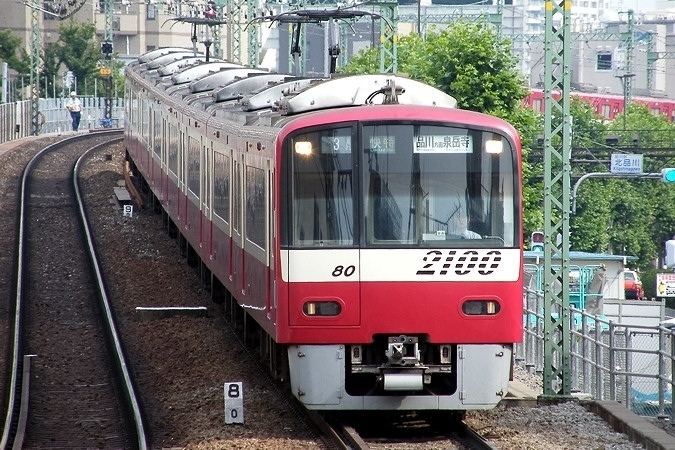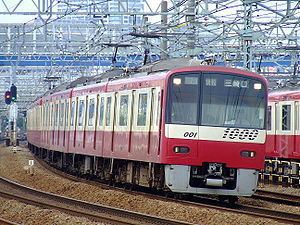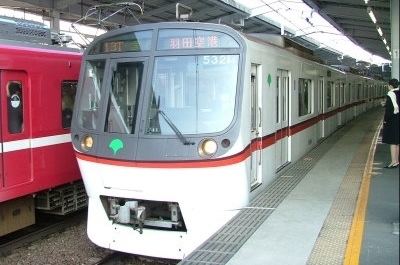Native name 京急本線 Depot(s) Kanazawa-Bunko | Opened 1901 Electrification 1,500 V DC overhead Stations 50 | |
 | ||
Daily ridership 1,129,320 (daily, FY2010) Track gauge 1,435 mm (4 ft 8 ⁄2 in) | ||
Tokyo japan keikyu main line railway crossing in shinagawa hd 2015
The Keikyu Main Line (京急本線, Keikyū-honsen) is a railway line in Japan, operated by the private railway operator Keikyu. The line connects the Tokyo wards of Minato, Shinagawa, Ōta, and the Kanagawa municipalities of Kawasaki, Yokohama and Yokosuka. The Keikyu Main Line began as a short 2 km line in 1895, and by 1905 had extended from Shinagawa Station in Tokyo to central Yokohama.
Contents
- Tokyo japan keikyu main line railway crossing in shinagawa hd 2015
- Tokyo japan keikyu main line trains at shimbamba station hd 2015
- Service types
- Stations
- History
- Accidents
- References

Tokyo japan keikyu main line trains at shimbamba station hd 2015
Service types
Keikyu operates the following different types of service, including all-stations "Local" trains.
Abbreviations:


Stations
For connections and distances, see the route diagram.
History

All sections of the line were built as dual track. The Keihin Railway opened the Kawasaki to Omori section in 1901 as a 1,435 mm gauge line electrified at 600 V DC. In 1904, the line was regauged to 1,372 mm and extended to Shinagawa.

In 1930, the Shonan Electric Railway opened the Uraga to Koganecho section as a 1,435 mm gauge line electrified at 1,500 V DC. In 1931, the line from Yokohama was extended to connect at Koganecho. Freight services ceased in 1932, the line was regauged to 1,435 mm the following year, and in 1936, the voltage on the Shonan line was reduced to 600 V DC.

In 1941, the Shonan Electric Railway merged with the Keihin Railway, which merged with Tokyu the following year. The voltage on the entire line was raised to 1,500 V DC in 1945, and in 1948, the Keihin Electric Railway was created to operate the railway.
From the start of the revised weekday timetable on 7 December 2015, two Morning Wing limited-stop commuter services from Miurakaigan on the Keikyu Kurihama Line to Shinagawa and Sengakuji in Tokyo were introduced. These stop at Yokosuka-chuo, Kanazawa-Bunko, and Kamiōoka en route.
Accidents
On 7 April 1997, at about 2:47 pm, the first three cars of a four-car train derailed after colliding with a mudslide, resulting in 22 people injured. The accident occurred between Keikyū Taura and Anjinzuka stations, with approximately 60 people on board. Heavy rains caused the mudslide, 7 months after a report by the train company to the Transportation Minister that there was little probability of such an occurrence in that area. 500 workers were mobilized as the train service was temporarily suspended between Kanazawa-Hakkei and Horinouchi stations.
On 24 November 2000, at about 5:20 am, the front car of a four-car train derailed after a truck collided with the first car of the train at a level crossing, resulting in injuries to three passengers. The accident occurred in Yokosuka, and the approximately 100 commuters on board later walked about 200 m to the nearest station to continue their journeys via bus. The driver of the truck reported his foot became stuck between the accelerator and brake pedals, sending him through the crossing bar and into the crossing. Normal operations continued about 4 hours later that morning.
On 24 September 2012, at about 11:58 pm, the first three cars of an eight-car train derailed after colliding with a mudslide, resulting in injuries to 28 people including the train driver. Seven men and women were seriously injured, including fractures, broken ribs and pelvises. The accident occurred between Oppama and Keikyū Taura stations, between Yokohama and Yokosuka, with approximately 700 passengers on board. Heavy rains caused the mudslide, sweeping away safety nets that had been installed in 1998, the year after a similar mudslide in the area. An area of soil about 12 metres high and 15 metres wide fell onto the tracks, bring trees and fencing structures with it. The train was travelling at 75 km/h before the driver applied the brakes, 30 to 40 metres before the mudslide. Train services were temporarily suspended between Kanazawa-Hakkei and Hemi stations and temporary bus services were provided by the train company until normal operations resumed approximately 55 hours later after the assessment and clean-up process.
On 18 April 2013, at about 4:30 pm, two window panes shattered in the front car of a commuter train while passing an express train going the opposite direction, resulting in minor lacerations to two high school students sitting with their backs to the windows. One window pane was also cracked on the passing train with no injuries. The accident occurred between Keikyu Taura and Anjinzuka stations, with approximately 30 people in the car at the time of the accident.
